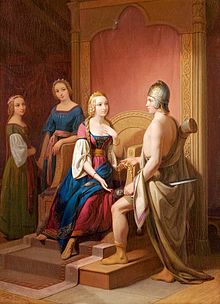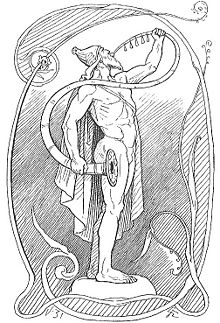Heimdall

Heimdall (Old Norse Heimdallr, the prefix Heim- means home, the affix -dallr is of uncertain origin) is one of the Æsir (gods) in Norse mythology. Heimdall is the guardian of the gods and of the link between Midgard and Asgard, the Bifrost Bridge. Legends foretell that he will sound the Gjallarhorn, alerting the Æsir to the onset of Ragnarök where the world ends and is reborn.
Heimdall, as guardian, is described as being able to hear grass growing and single leaves falling, able to see to the end of the world, and so alert that he requires no sleep at all. Heimdall is described as a son of Odin, perhaps a foster son. Heimdall was destined to be the last of the gods to perish at Ragnarök when he and Loki would slay one another.
Characteristics

Heimdall is described as the son of nine different mothers (possibly the nine daughters of Ægir, called billow maidens) and was called the White God. His hall was called Himinbjörg (Sky Mountain) and his horse was Gulltoppr (Gold-top). Snorri Sturluson's Prose Edda relates that a kenning for sword is head of Heimdall because Heimdall was struck by a man's head and that this is treated in the poem Heimdalargaldr, a poem unfortunately lost. Similarly, a kenning for head is sword of Heimdall. The meaning may lie in Heimdall also being called "ram", the weapon of a ram being its head, including the horns. Georges Dumézil (1959) suggested that this might also be why Heimdall is called White-god.
Heimdall's nickname Hallinskíði ("Bent Stick") also appears as a kenning for "ram", perhaps referring to the bent horns on a ram's head. Heimdall's nickname Gullintanni ("Golden-Toothed") would refer to the yellow coloring found in the teeth of old rams. A third name for Heimdall is Vindhlér ("Wind Shelter"). Dumézil cites Welsh folklore sources which tell how ocean waves come in sets of nine with the ninth one being the ram:
We understand that whatever his mythical value and functions were, the scene of his birth made him, in the sea's white frothing, the ram produced by the ninth wave. If this is the case, then it is correct to say that he has nine mothers, since one alone does not suffice, nor two, nor three.
Old Welsh practice, modern French practice and modern Basque practice is to refer to white-capped waves as sheep.
Poetic Edda

Völuspá
The first stanza of the Poetic Edda poem Völuspá proclaims:
I ask for a hearing of all the holy races
Greater and lesser, kinsman of Heimdall.
The Eddic poem Rígsthula explains how these races are kinsmen of Heimdall; the god Ríg, identified with Heimdall in a short prose introduction, apparently fathered the progenitors of the three classes of humankind, the youngest of which fathered in turn Kon the Young (Old Norse Kon ungr), the first immortal king (Old Norse konungr).
Þrymskviða
H. R. Ellis Davidson proposes a link between Heimdall and the Vanir [1] as do some others, partly based on stanza 15 of the Poetic Edda poem Þrymskviða:
Then Heimdall spoke, whitest of the Æsir,
Like the other Vanir he knew the future well.
However other can be also translated even, which would mean instead that Heimdall had foresight "even" as do the Vanir.
Davidson also notes a connection with Freyja, given that one of her names, Mardoll, matches his, with mar meaning "sea" and heim meaning "earth".[1]
Prose Edda

Húsdrápa and Heimdallargaldr
The lost Heimdallargaldr may have contained the following adventure which was also referenced in Úlfr Uggason's skaldic poem Húsdrápa of which only fragments are preserved:
Once, Freyja woke up and found that someone had stolen Brisingamen. Heimdall helped her search for it and eventually found the thief, who turned out to be Loki and they fought in the form of seals at Vágasker 'Wave-skerry' and Singasteinn, wherever they may be. Heimdall won and returned Brisingamen to Freyja.
Theories

Georges Dumézil considers Heimdall an old Indo-European god, a type of god he calls first god which is different from being the highest god. The Thessalian god of Romans Janus would be the Roman reflex to this concept. But there are other first gods. Heimdall is also a frame god, one who appears at the beginning and remains until the end.[2]
Dumézil suggested that the Hindu counterpart was the god Dyaus, one of the eight Vasus, who reincarnated as the frame hero Bhishma in the epic Mahabharata, he and his seven brothers being born to a mortal king by the River Ganges who herself had taken on mortal form. But the seven other brothers are returned to their immortal forms by being drowned by their mother immediately after birth.[2]
Only Dyaus was compelled to live a full life on earth in the form of Bhishma. Bhishma is destined to never hold power himself or have any direct descendants but acts as an ageless uncle on behalf of the line of lords that tortuously descend from his half-brothers, including finally the five Pandava brothers who represent four classes of society: royalty, noble warrior, lower class club-bearing warrior, and herdsmen. Bhishma is the last to die in the great battle of Kurukshetra.[2]
However Branston (1980) considers Heimdall to correspond to the Vedic Agni god of fire, who in many Vedic texts is born from the waters or hides within the waters and who is born from two, seven, nine, and ten mothers in various sources, the ten mothers being sometimes explained as the ten fingers which can manipulate a bore-stick to produce fire. This accords with Viktor Rydberg's theories on Heimdall.
See also
References
- ^ a b Davidson, H.R. Ellis (1990) [1964]. "The Enigmatic Gods". Gods and Myths of Northern Europe. Penguin. p. 175. ISBN 0-14-013627-4.
It is true that this connexion with the Vanir is implied rather than clearly obvious, but it is implied at several different points.
- ^ a b c Dumézil, Georges (1959) "Comparative Remarks on the Scandinavian God Heimdall", Gods of the Ancient Northmen. Ed. Einar Haugen, trans. Francis Charat (1973) Berkeley: University of California Press. ISBN 0-520-03507-0.
External links
- [1] William Sayers, "Irish Perspectives on Heimdallr," Alvíssmál 2 (1993): 3–30.
- [2] Karl G. Johansson, "Rígsþula och Codex Wormianus: Textens funktion ur ett kompilationsperspektiv," Alvíssmál 8 (1998): 67–84 (English summary, p. 84).
- [3] Frederic Amory, "The Historical Worth of Rígsþula," Alvíssmál 10 (2001): 3–20.
